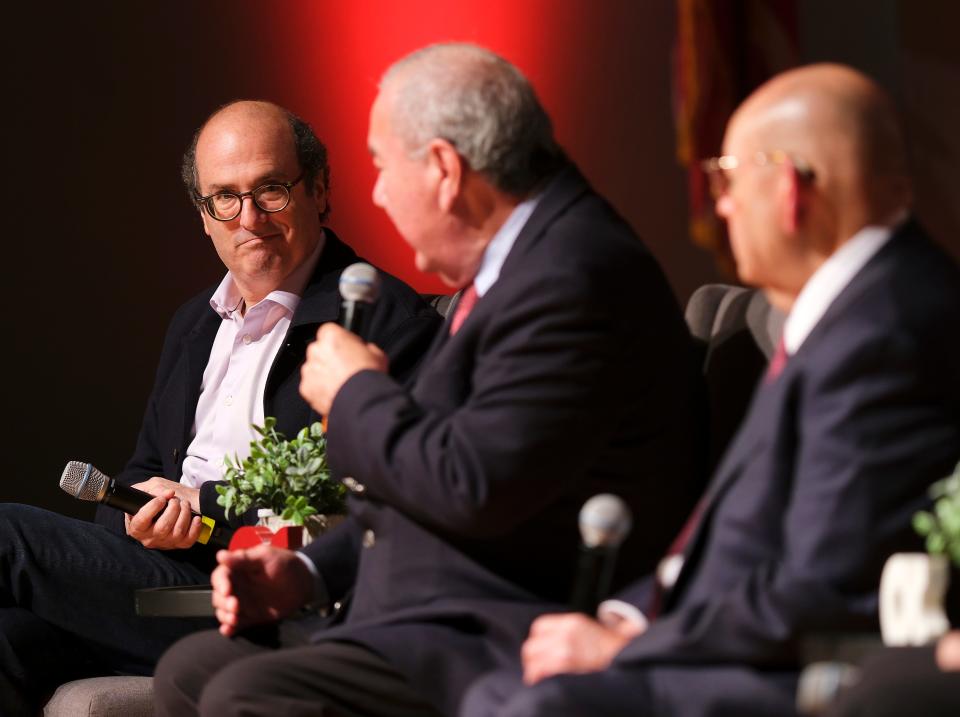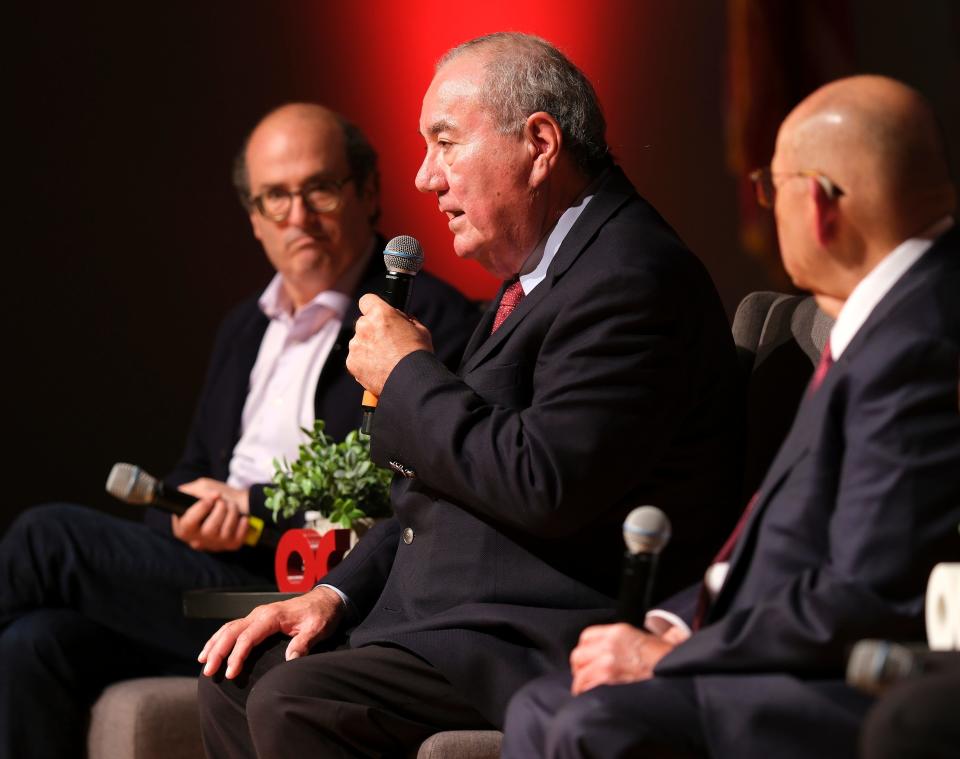'Killers of the Flower Moon' writer David Grann returns to Oklahoma ahead of movie's debut
Just a few hours after he walked the red carpet at the Los Angeles premiere of "Killers of the Flower Moon," author David Grann flew back to the place where history changed his life.
"When I wrote that book ... it took half a decade, and when I finished the book, I really didn't know if anybody would read it. I really did not. I never expected this — never," Grann told hundreds of people who turned out Tuesday to hear him talk about "Killers of the Flower Moon" at a panel discussion at Oklahoma Christian University in Edmond.
"I remember my wife taking me aside and saying, 'You know, whatever happens' — I think she was worried about my psyche — 'you did something that you believed in. And that's what matters.'"
Just a few days before cinema legend Martin Scorsese's star-studded adaptation of his 2017 New York Times best-seller makes its Oct. 20 global theatrical debut, Grann, 56, was back in Oklahoma, sharing the stage with Osage Nation Principal Chief Geoffrey Standing Bear and contemplating the ways that "Killers of the Flower Moon" has altered the course of his life.

"It certainly has been changed in so many ways. I'll say, though, the deepest way ... is these personal friendships that I have developed with the chief and with so many others. This is a project that kind of went on, and the conversation hasn't ended. I mean, we just keep these conversations going, which, to me, is the most rewarding thing," Grann said during the panel, which also included Chickasaw Nation Gov. Bill Anoatubby and FBI Special Agent Edward Gray.
What are the differences between David Grann's book and Martin Scorsese's movie 'Killers of the Flower Moon?'
Adapted from Grann's 2017 National Book Award finalist “Killers of the Flower Moon: The Osage Murders and the Birth of the FBI," Scorsese's $200 million fact-based Western saga is the biggest movie ever made in Oklahoma.
"A film and a book are always two different things — and they should be. They are different mediums. But I think they complement each other really well, and they both, I think, arrive at the same deeper truth," Grann told The Oklahoman after Tuesday's panel.
"The movie does a remarkable job."
Filmed in and around the Osage Nation in 2021, Scorsese's almost 3 1/2-hour cinematic epic — like Grann's book — drills down into the dark history of the "Reign of Terror," a sinister series of slayings of Osage Nation citizens in 1920s Oklahoma, after an oil boom made them the wealthiest people in the world per capita.
Between 1920 and 1925, there were more than 60 mysterious or unsolved murders on the northeastern Oklahoma prairie, all connected with Osage Nation citizens who were entitled to a share of the tribe's vast oil riches. Some were shot, some were poisoned, and some were even bombed, eventually leading to an investigation by the U.S. Bureau of Investigation, the forerunner of the FBI.
"The book is a very sweeping history: It goes all the way back to when the Osage met with Thomas Jefferson in the White House back in the early 1800s, all the way into the present," said Grann, who also gave a lecture, participated in a Q&A and signed books Tuesday during his visit at OC.
"It's told in these three parts: The first part is from the perspective of Mollie Burkhart, this Osage woman who's been systematically targeted, and the second part is told from the bureau's investigation. Then, the third part is told from the present and tries to illuminate how there were many more of these killings that were never resolved — and that there really was this culture of killing, culture of complicity."
Grann said the movie zooms in on the relationship between Mollie (Lily Gladstone, who is NiMíiPuu, or Nez Perce, and Siksikaitsitapi, or Blackfeet) and her traitorous husband, Ernest Burkhart (Oscar winner Leonardo DiCaprio), who gets caught between his love for his wife and the deadly machinations of his greedy uncle, William K. Hale (Oscar winner Robert De Niro).
"(It) is really representational of what took place," Grann said. "In doing that kind of character study and exploring and exhuming that relationship, it's able to illuminate a lot of the larger crimes that took place — and the sins and the greed and the betrayal."

Osage chief says David Grann 'really changed the world'
A staff writer for The New Yorker magazine, Grann's articles and nonfiction books have previously been turned into the movies "The Old Man & the Gun," "Trial by Fire," "The Lost City of Z" and "Dark Crimes."
Although he was impressed when he returned to Oklahoma in 2021 to visit the set of "Killers of the Flower Moon" with his family, the journalist said he doesn't know much about filmmaking.
"I spend most of my time just in archives or interviewing people, and so my hope, always, with these projects is to get it into the hands of people who do know what they're doing. I felt incredibly fortunate that it ended up with perhaps the greatest living film director of our time," Grann said of Scorsese.
"The only thing I really cared about was, when I worked on my book, I spent many, many years developing relationships — speaking with Osage elders, speaking with the chief. My book is a product of those interviews ... and that trust that they shared with me. And I thought it was really important — because a film is going to be its own thing — that they begin to develop those relationships similarly, and that they work so closely with members of the Osage Nation."
Standing Bear, who has praised Scorsese and his team for partnering with the Osage Nation throughout the making of "Killers of the Flower Moon," was quick to point out that the world wouldn't be eagerly awaiting the film without Grann's devotion to telling the tribe's story.
"None of us would be here without David Grann. That is a fact. He's really changed the world," Standing Bear said. "I've seen the movie four times, and it is deeper and deeper and deeper. But you really need — and I'm not saying this because David's here — to read the book before you watch the movie, because David's book will show you this is a true story. No doubt about it.
"And what Marty Scorsese does, is he personalizes it into relationships: relationships between a man and a woman and the Osage people in the outside world."

'Killers of the Flower Moon' author says he might not be done with Oklahoma
During the almost six years Grann spent working on "Killers of the Flower Moon," Standing Bear said the writer became a part of the community.
"This story is not unknown to us in the Osage (Nation) — we just didn't talk about it," the chief said, thanking the author. "His book has impacted us so much, and the range of emotions are incredible. It's bringing out a lot of new discussion among the Osage on a matter we never talked about before."
Grann has released other nonfiction books since his best-selling Reign of Terror chronicle, including "The White Darkness," "The Wager: A Tale of Shipwreck, Mutiny and Murder" and a "Young Readers Edition" of "Killers of the Flower Moon."
A Connecticut native based in New York, he has made many trips to Oklahoma since he started delving into the history of the Reign of Terror. Grann told The Oklahoman he continues to be fascinated by the Sooner State's complicated history.
"Oklahoma is about as rich with stories as any place in the country. I sat on the panel today and was listening to the governor tell stories about his own nation," Grann said, indicating Chickasaw Gov. Anoatubby.
"So, I wouldn't be surprised if I found myself back here in Oklahoma one day working on a new story."

This article originally appeared on Oklahoman: 'Killers of the Flower Moon' author tells difference between book, film
